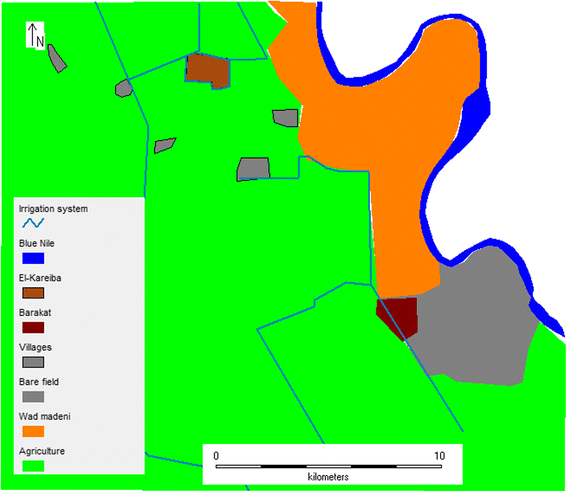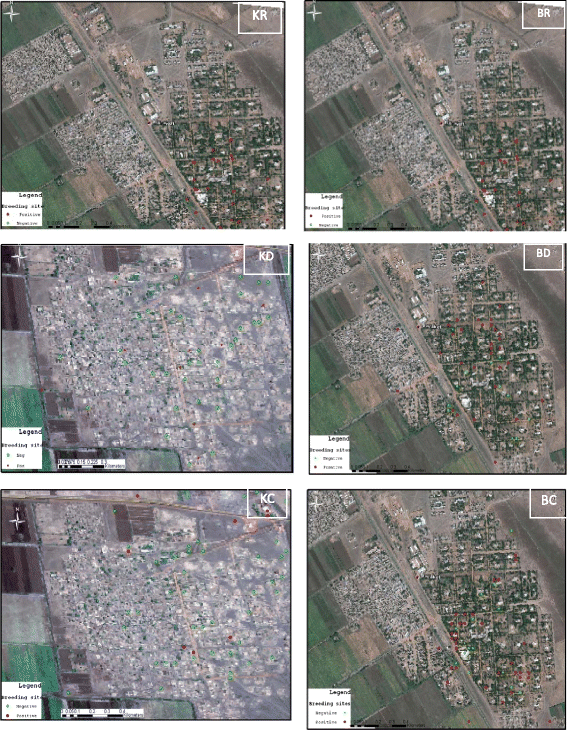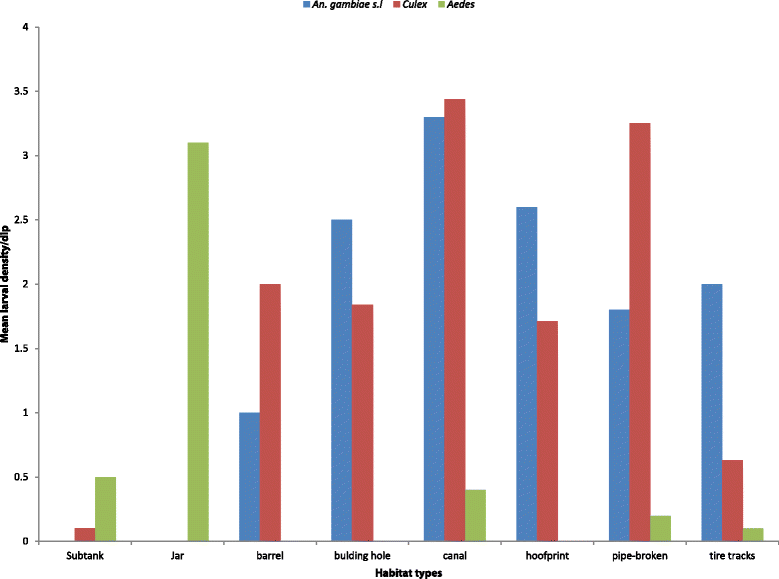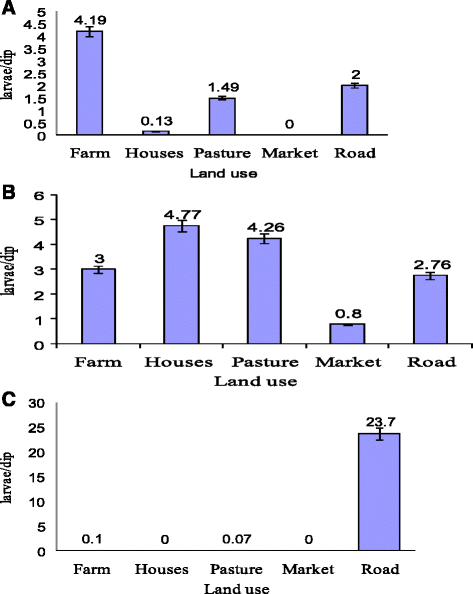Characterisation of larval habitats, species composition and factors associated with the seasonal abundance of mosquito fauna in Gezira, Sudan
- PMID: 28173839
- PMCID: PMC5297020
- DOI: 10.1186/s40249-017-0242-1
Characterisation of larval habitats, species composition and factors associated with the seasonal abundance of mosquito fauna in Gezira, Sudan
Abstract
Background: Larval source management (LSM), which requires an understanding of the ecology and composition of the local mosquito fauna, is an important parameter in successful vector control programmes. The present study was conducted to understand the distribution of larval habitats, species composition and factors associated with the seasonal abundance of mosquito larvae in Gezira irrigation Scheme in Gezira state, central Sudan.
Methods: Cross-sectional larval surveys were carried out in the communities of Barakat (urban) and El-Kareiba (semi-urban), in Wad Madani, Gezira. A standard dipper was used for sampling larvae in all possible breeding sites and enamel bowls were employed for larvae sorting. Habitats were characterised using physical features and all larvae specimens were identified morphologically.
Results: A total of 331 larval habitats were surveyed, out of which 166 were found to be positive breeding sites for Anopheles (56.78%), Culicinae (29.67%) and Aedes (13.55%) species. A total of 5 525 larvae collected were categorised as Culex (2 617, 47.37%), Anopheles (2 600, 47.06%) and Aedes (308, 5.57%). There was a high number of positive habitats during the rainy season, while the lowest proportion was reported during the hot dry season, in both study sites (Barakat [χ 2 = 10.641, P = 0.0090], El-Kareiba [χ 2 = 23.765, P = 0.0001]). The main breeding site for Anopheles larvae was leaking water pipes (51.5%), followed by irrigation channels (34.2%), hoof prints (6.4%), tyre tracks (5.5%) and water tanks (2.4%). A logistic regression analysis showed that the abundance of Anopheles larvae was reduced by the presence of predators (backswimmers, tadpoles) and grass cover. Adult productivity (number of adult females emerged/m2) was not homogeneousfor all habitats; the highest productivity was found in irrigation channels (0.78 females/m2) for Anopheles, and in septic tanks (2.86 females/m2) for Culicinae and (0.86 females/m2) for Aedes. Anopheles arabiensis was found to be the dominant Anopheles species. This study documented the presence of An. funestus in central Sudan for the first time.
Conclusions: Maintaining leaking water pipes and adopting intermittent irrigation are recommended for LSM, as these surveyed habitats represent the main source of maintaining the local mosquito population during the hot dry season.
Keywords: Aedes; Anopheles; Culex; Gezira; Habitats; Larvae; Mosquitoes; Seasonal abundance.
Figures




Similar articles
-
Spatial distribution and habitat characterization of mosquito species during the dry season along the Mara River and its tributaries, in Kenya and Tanzania.Infect Dis Poverty. 2018 Jan 18;7(1):2. doi: 10.1186/s40249-017-0385-0. Infect Dis Poverty. 2018. PMID: 29343279 Free PMC article.
-
Diversity and abundance of mosquito species in relation to their larval habitats in Mizoram, North Eastern Himalayan region.Acta Trop. 2014 Sep;137:1-18. doi: 10.1016/j.actatropica.2014.04.026. Epub 2014 Apr 30. Acta Trop. 2014. PMID: 24795213
-
Seasonal mosquito larval abundance and composition in Kibwezi, lower eastern Kenya.J Vector Borne Dis. 2009 Mar;46(1):65-71. J Vector Borne Dis. 2009. PMID: 19326710
-
A meta-analysis reveals that dragonflies and damselflies can provide effective biological control of mosquitoes.J Anim Ecol. 2023 Aug;92(8):1589-1600. doi: 10.1111/1365-2656.13965. Epub 2023 Jun 4. J Anim Ecol. 2023. PMID: 37272224 Review.
-
Naturally Occurring Microbiota Associated with Mosquito Breeding Habitats and Their Effects on Mosquito Larvae.Biomed Res Int. 2020 Dec 14;2020:4065315. doi: 10.1155/2020/4065315. eCollection 2020. Biomed Res Int. 2020. PMID: 33381553 Free PMC article. Review.
Cited by
-
Larval ecology and bionomics of Anopheles funestus in highland and lowland sites in western Kenya.PLoS One. 2021 Oct 11;16(10):e0255321. doi: 10.1371/journal.pone.0255321. eCollection 2021. PLoS One. 2021. PMID: 34634069 Free PMC article.
-
Long-lasting microbial larvicides for controlling insecticide resistant and outdoor transmitting vectors: a cost-effective supplement for malaria interventions.Infect Dis Poverty. 2020 Nov 26;9(1):162. doi: 10.1186/s40249-020-00767-3. Infect Dis Poverty. 2020. PMID: 33243294 Free PMC article.
-
Using ecological observations to improve malaria control in areas where Anopheles funestus is the dominant vector.Malar J. 2022 Jun 2;21(1):158. doi: 10.1186/s12936-022-04198-3. Malar J. 2022. PMID: 35655190 Free PMC article. Review.
-
The Interspecific Competition Between Larvae of Aedes aegypti and Major African Malaria Vectors in a Semi-Field System in Tanzania.Insects. 2024 Dec 31;16(1):34. doi: 10.3390/insects16010034. Insects. 2024. PMID: 39859615 Free PMC article.
-
Mitigating the Public Health Issues Caused by the Filarial Vector, Culex quinquefasciatus (Diptera: Culicidae) Through Phytocontrol and Larval Source Marker Management.Appl Biochem Biotechnol. 2024 Aug;196(8):5013-5044. doi: 10.1007/s12010-023-04747-9. Epub 2023 Nov 24. Appl Biochem Biotechnol. 2024. PMID: 37999898
References
MeSH terms
LinkOut - more resources
Full Text Sources
Other Literature Sources

